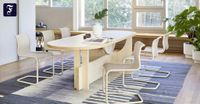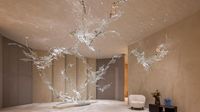The Salone del Mobile 2025 in Milan has once again transformed the city into a vibrant hub for the international interior design scene, attracting hundreds of thousands of enthusiasts eager to witness the latest trends. This year, the fair showcased an array of innovative designs, from timeless furniture pieces to cutting-edge sustainable concepts, reflecting the evolving landscape of modern living.
One of the standout pieces at the fair was the Sen chair, designed by the renowned Canadian-American duo Yabu Pushelberg for the Dutch brand Leolux. This chair, with its striking u-shaped metal tubes enveloped in fabric, is not just a visual delight but also a source of comfort and serenity. Its design is so compelling that it is expected to secure a place in prestigious collections in cities like Munich, London, and New York. The chair embodies a gentle wave, creating an inviting atmosphere for relaxation.
Another highlight was a reimagined Bauhaus-era chair, continuously refined by Tecta over the years. This chair, featuring a metal frame and a woven design, promotes spinal health thanks to its flexible structure, allowing users to sit comfortably while providing support for their back and spine.
The modular storage concept Vision, originally designed 40 years ago by Pierre Mazairac and Karel Boonzaaijer for Pastoe, has made a significant comeback. Now re-released by Arco in various sizes, shapes, and colors, these storage units are not just functional but also visually appealing. The doors seamlessly integrate into the body of the unit, creating a cohesive look without the need for handles, as they open and close with a gentle touch.
Naoto Fukasawa's Mostar stool was another captivating piece, carved from a single tree trunk and adorned with intricate carvings that reflect the flowing waters of the Neretva River. This stool symbolizes unity and connection among peoples, paying homage to the historic bridge in Mostar, which was destroyed during the Bosnian War in 1993 and later rebuilt. The craftsmanship behind this piece is a testament to the dedication of the Zanat company, run by brothers Orhan and Adem Nikšić, who are committed to reviving the ancient art of wood carving from Konjic, recognized as a UNESCO World Heritage Site since 2017.
Ronan Bouroullec's Ancora table also drew attention, featuring a concrete base and a round tabletop. This table pays tribute to the legacy of Italian architect Pier Luigi Nervi and designer Angelo Mangiarotti, both known for their innovative use of materials. The combination of concrete with natural wood creates a striking contrast that resonates with current design trends.
In a bold move towards sustainability, the Catifa Carta 53 chair, designed over 20 years ago by Lievore Altherr Molina, is now crafted using PaperShell, a cellulose fiber composite that is both durable and recyclable. This innovative material, referred to as "wood metal," can be transformed into biochar and used as fertilizer at the end of its life cycle, exemplifying the principles of sustainable design.
As the fair progressed, several key trends emerged, reflecting the industry's response to changing consumer preferences and environmental considerations. One notable trend was the increasing use of natural materials, particularly stone. Following last year's emphasis on stone surfaces, this year saw a continuation of this trend, with B&B Italia incorporating fabrics that mimic stone textures into their designs.
In contrast, glass structures emerged as a counter-movement to traditional materials like granite and marble. Designers are exploring the limits of glass, creating mouth-blown lights, vases, and furniture components that challenge the scalability of this material. While mouth-blown items are limited in size, alternative techniques such as pressed and cast glass are expanding design possibilities.
The revival of 70s aesthetics remains a strong influence, with softer sea blues replacing the bold Yves-Klein blue of previous seasons. This trend is often paired with warm reds and browns, reflecting a nostalgic nod to retro color palettes. For instance, the terracotta-colored 'Torei' coffee table at Cassina and cognac-colored leather on Cor's new 'Kagu' chair exemplify this resurgence of warm tones.
Outdoor living continues to blend with indoor spaces, as manufacturers push the boundaries of comfort and style in outdoor furniture. Italian brands like Gervasoni are leading the charge by introducing bold colors and innovative upholstery for their teak loungers, which feature orange-red striped cushions and are complemented by elegant Mediterranean tables and ceramics.
Simple, round wall lights emerged as another popular design element, showcasing organic forms that contrast with the digital age's complexities. These wall fixtures, resembling light frisbees, offer a minimalist aesthetic that is both functional and visually pleasing.
Lastly, the trend of chrome-glossy and mirrored surfaces continues to dominate, reflecting the glamour of the 80s while integrating modern design elements. This year's Salone featured numerous installations showcasing reflective surfaces, combining high-gloss lacquered furniture with glass and chrome elements, creating a dazzling visual experience.
As the Milan Furniture Fair wraps up, it is clear that the event not only highlights the latest design trends but also serves as a barometer for the industry's future direction. With a focus on sustainability, craftsmanship, and innovative materials, the designs showcased this year promise to shape the way we think about and experience our living spaces.


